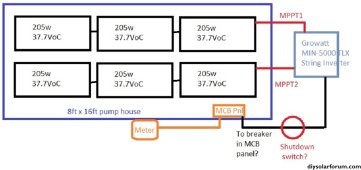Rednecktek
Solar Wizard
OK, so I like the idea of string inverters over micro inverters, they make more sense to me. I've been eyeballing the Growatt MIN 5000TL for a while now and I'm noodling out a small grid tie system just to offset some of the bill for the little bit of time I'm up there. I have a half dozen panels already up there collecting dust. As I understand it the panels aren't allowed to overhang the roof which severely limits me as the panels are longer than the peak-to-edge distance of the pump house. Here's my basic concept doodle:

So a few thoughts and questions for y'all:
Washington is under NEC2020, and the Growatt is UL1741 so does that make it work by code?
As I understand it the racking and standoffs to the roof have to be UL listed? What kind of standoffs and racking does that entail for regular metal roofing (I.E NOT the standing seam or wavy corrugated)?

I also understand that NEC2020 requires all the wires to be in metal conduit? Is that between the panels as well or just from the panels to the inverter or just the output of the inverter to the main power panel? If it's between the solar panels, how the hell do you get all the terminals in there?
Rapid shutdown, is that a button switch between the panels and inverter or the inverter and the main power panel? Or does the "anti-islanding" feature of the Growatt satisfy that?
The Growatt would just go to a double pole breaker in the main panel, correct? Or am I going to have to get a second meter mounted by the PUD that the growatt ties into directly?
What are the little "Gotcha!'s" that y'all have run into trying to DIY a grid tied system?
Thanks y'all!

So a few thoughts and questions for y'all:
Washington is under NEC2020, and the Growatt is UL1741 so does that make it work by code?
As I understand it the racking and standoffs to the roof have to be UL listed? What kind of standoffs and racking does that entail for regular metal roofing (I.E NOT the standing seam or wavy corrugated)?
I also understand that NEC2020 requires all the wires to be in metal conduit? Is that between the panels as well or just from the panels to the inverter or just the output of the inverter to the main power panel? If it's between the solar panels, how the hell do you get all the terminals in there?
Rapid shutdown, is that a button switch between the panels and inverter or the inverter and the main power panel? Or does the "anti-islanding" feature of the Growatt satisfy that?
The Growatt would just go to a double pole breaker in the main panel, correct? Or am I going to have to get a second meter mounted by the PUD that the growatt ties into directly?
What are the little "Gotcha!'s" that y'all have run into trying to DIY a grid tied system?
Thanks y'all!


